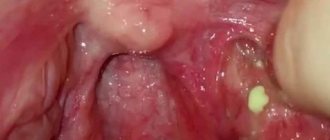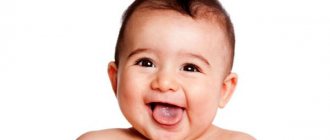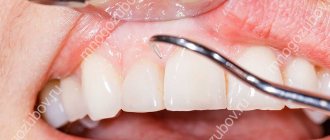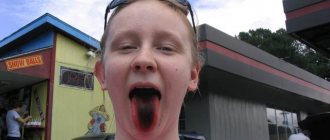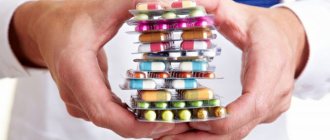A white tongue in a newborn after feeding is a common occurrence. These are milk residues; removing them from the surface will not be difficult. But the appearance of a thick, cheesy coating in the mouth, anxiety, and poor appetite in a child indicate more serious reasons and require the help of a pediatrician. The doctor will determine why the baby has a white coating on the tongue and will develop an effective treatment regimen.
Possible reasons for the appearance of white plaque
The appearance of a white coating on a child’s tongue is considered a common occurrence. The development of this pathological process may be preceded by various reasons.
Among them, pediatricians primarily determine:
- If a white coating appears on a child’s tongue, you should immediately show the baby to a pediatrician
Milky plaque. It is formed as a result of the accumulation of milk residues on the surface of the tongue after feeding. Characterized by the localization of small spots that are easily removed. In most cases, a whitish coating on the tongue of a child under one year of age is a natural phenomenon.
- Fungal infections. The development of candidiasis is characterized by the formation of a large amount of white discharge of a cheesy and dense consistency. Additionally, plaque can cover the mucous membrane of the cheeks, palate and gums.
In addition, at an advanced stage of the pathology, it spreads to the umbilical wound and the mucous membrane of the genital organs.
Important! If a white coating appears on a child’s tongue, you should immediately show the baby to a pediatrician. Only a qualified specialist will be able to correctly determine the cause of plaque and prescribe appropriate treatment.
Causes
The main reason for the development of candidiasis of the oral mucosa in children is weakened immunity. If a baby is born premature, the likelihood of developing thrush is very high. Children who are breastfed or have congenital pathologies are also often exposed to fungal infections.
Provoking factors include:
- the presence of vaginal candidiasis in the mother during pregnancy (the child can become infected when passing through the birth canal);
- insufficient hygiene of the female breast during breastfeeding (the fungus is often localized specifically on the nipples due to the environment favorable for it);
- poor handling of the child’s initial things (bottles, pacifiers, etc.);
- parents’ habit of licking nipples (even if the adult has no signs of thrush, there may be a fungus in the mouth that can be passed on to the child);
- long-term use of drugs from the “antibiotics” group (medicines help reduce one’s own immunity);
- frequent regurgitation in infants (after regurgitation, an increased acidic environment will remain inside the oral cavity, favorable for fungus);
- excessive and frequent dry mouth (lack of saliva as a protective agent against the activity of pathological microorganisms).
Infection with Candida fungus in children over 2 years of age can occur as a result of consuming unwashed foods, raw milk or running water. If a child over 3 years of age suddenly shows signs of thrush, they should be examined not only for a fungal infection, but also for other possible diseases that may be accompanied by a “decay” of the immune system.
Diagnosis of the newborn's condition
The appearance of a white coating on the tongue of a newborn does not always indicate the development of any pathology. But despite this, it is recommended to carefully analyze changes in the child’s behavior.
If necessary, do not neglect a consultation with a pediatrician, where the cause of its appearance will be accurately determined and appropriate treatment will be selected.
The table will help us understand the reason for the appearance of a white coating on the tongue of a baby:
| When not to worry | Cause for concern |
| White spots | |
| The area of the spots is not large, evenly covering the back of the tongue. A thin layer is formed from the peeled horny scales, through which the papillae are visible. The spots are characterized by a whitish color and easy removal, after which no damage to the mucous membrane is observed. The child behaves well, is gaining weight steadily and is not capricious when feeding. | The area of the tongue is covered with spots of a dense and curd-like consistency, especially its back. The lateral areas of the tongue are covered with bubbles with transparent exudate. The child's behavior becomes capricious due to the appearance of pain when sucking the breast or pacifier. |
| White dots | |
| On the tongue, the points are located evenly over the entire area and are characterized by a thin layer. There is no cause for alarm if dots appear on the tongue immediately after your child consumes dairy products. | Focal arrangement of points on the surface of the tongue. The child refuses the breast, body temperature rises. Erosion may form at their localization sites. In the event that a child exhibits additional symptoms or concomitant diseases: glossitis, stomatitis, tonsillitis, scarlet fever, chronic vitamin deficiency, diphtheria, ARVI, scarlet fever. |
| White plaque on lips | |
| The mucous membrane of the oral cavity and the sponges themselves are light pink. If the white coating on the lips is a crust of callus that appears when sucking the breast. When natural atrophied epithelial cells accumulate on the lips, palate and gums, especially in the first days of life. | After feeding, the amount of plaque does not decrease, but constantly increases in size, affecting an increasingly larger area of the oral mucosa. The plaque layer is dense and continuous. The child's behavior deteriorates sharply for the worse. Refusal to feed, or the child abruptly throws the breast or bottle only after putting it in his mouth. |
Symptoms of thrush in the mouth of a baby
What does thrush look like in a baby? When a fungal infection enters the child’s oral mucosa, its proliferation leads to inflammation in the mouth area. Therefore, quite quickly you will be able to notice small crumbs of white “cereal”, reminiscent of cottage cheese, on the child’s cheeks, palate, gums and tongue. An inexperienced mother may well assume that this is the remains of milk or formula after regurgitation. But checking whether this is so is quite simple: take dry sterile gauze or a bandage and very carefully try to remove the white coating. If these are really leftover food, they will be easily removed; if it is thrush, it will be more difficult to erase the curdled coating. And after removing it, you will notice inflamed redness in the oral cavity. If your baby has thrush, his appetite and sleep will most likely worsen, and he will become restless and moody.
If it is a milky coating on the tongue of a baby
Milky deposits on a baby’s tongue can be easily removed by cleaning with a gauze cloth soaked in warm boiled water.
In most cases, the white coating on the child’s tongue disappears on its own some time after eating.
After regurgitation, white food particles may also remain on the tongue, forming a film that can and should be easily cleaned.
The occurrence of plaque is promoted by high humidity and high air temperature in the apartment where the child lives.
Also, such plaque may appear due to allergic reactions to mixtures, complementary foods, and medications.
This etiology of milk plaque is a normal physiological reaction of the child’s body.
It is easy to remove if you clean it with a gauze cloth soaked in warm boiled water. Such plaque does not pose any danger to the health of the baby.
White coating on the tongue can also be regarded as a symptom of various pathologies:
- Diseases of the respiratory system: with bronchial asthma, in the first stages of the development of the disease, plaque appears on the tip of the tongue, then covers the entire tongue.
- In case of influenza, ARVI, sore throat, the tongue is completely covered.
- Diseases of the gastrointestinal tract: with gastritis, plaque is located in the middle of the tongue. A white dense layer covers the entire surface of the tongue during dysbacteriosis.
- Dental problems: stomatitis and caries.
Important! When the first small areas of milky plaque appear on your child’s tongue, you should consult your pediatrician. He will accurately differentiate milk plaque from candidiasis and select the appropriate treatment.
Natural color of the tongue in a healthy child
There are many cases when light-colored accumulations on the uvula do not require treatment. For example, during the examination in the morning, the mother may notice light deposits in a small amount. They are easy to clean off and are considered normal. At 1 year of age, such plaque is also diagnosed. These are often milk traces from mother's milk or its substitutes. Therefore, a thin light film is quite acceptable. But the natural shade of the surface of the tongue should be visible through it.
In healthy children, the color of the muscle organ is pale pink. At the same time, it must be mobile, all movements must be made unhindered and without difficulty. The condition of a child's tongue is significantly affected by humidity levels, as well as the temperature in the room where the baby is. For self-diagnosis, the mother needs to conduct visual examinations of her child’s oral cavity. Cleaning the baby's mouth is also necessary. First, this is done using special pharmaceutical wipes, and when the child grows up, a children's brush with a surface for treating the tongue is used.
Fungal infection
The development of thrush in the child’s mouth occurs as a result of the growth of Candida fungi. Intensive reproduction of pathogenic microorganisms occurs as a result of the influence of various factors.
Often babies become infected with thrush during childbirth, crossing the birth canal
These include:
- Weakened immune system.
- Dysfunctions of the microflora of the gastrointestinal tract.
- Hormonal disorders.
- Conducting antibacterial therapy.
- Excessive dryness of the oral mucosa.
Infection with Candida fungi occurs under the following conditions:
- In utero. Infection can occur through the placenta, umbilical cord and amniotic fluid.
- During childbirth. Often babies become infected with thrush during childbirth, crossing the birth canal. Therefore, it is important for women to exclude the development of thrush, especially in the last stages of pregnancy.
- Finding a child in a hospital and maternity hospital. Inappropriate and non-sterile care of the child contributes to the child becoming infected from health care workers.
- Poor sanitary conditions at home. Babies are born with a weakened immune system. Therefore, keeping a child in an unsterile home environment promotes the penetration of various microorganisms and bacteria into his body.
Diagnosis of candidal glossitis involves a complete collection of anamnesis data and conducting various types of comprehensive research.
Important! In most cases, when diagnosing thrush in a child, an instrumental examination is not performed.
For these purposes the following is carried out:
- Microscopic examination of the oral mucosa by taking a scraping from plaque and then examining it under a microscope. This allows you to determine the presence of Candida mycelium threads and yeast-like cells.
- Bacteriological research. Allows you to identify the type of Candida fungus and the number of its colonies. Sowing mushrooms on a nutrient medium helps install the most effective antifungal drug. This is necessary, since many medications have different effects on grown fungal colonies.
- Serological study. It is carried out if necessary to study antibodies that are concentrated in the blood serum.
Dangers of candidiasis for a newborn
Candidiasis can occur in simple and complex forms. And depending on the degree, it contains certain dangers:
- in severe forms of thrush, the fungus can reduce immunity and disrupt the gastrointestinal tract;
- candidiasis in a girl can spread to the vaginal mucosa, creating the risk of a pathology called synergy - fusion of the labia or vaginal mucosa;
- a mild form of thrush, in which it is enough to treat the plaque, usually does not pose any danger;
- with moderate thrush, inflammation forms under the white coating, which begins to bleed during treatment; this form brings additional discomfort and pain to the child; in the absence of proper treatment, the disease can become more severe;
- in severe cases of the disease, the fungal infection spreads throughout the entire oral cavity; in addition to pain and discomfort, the child may have a fever; Difficulties with swallowing can lead to the baby refusing not only food, but also water, which leads to rapid dehydration; this condition is life-threatening for the child, so its treatment is sometimes carried out in a hospital;
- thrush can occur not only in the acute, but also in the chronic stage: in such cases, exacerbation is characterized by the appearance of plaque on the mucous membranes and dry mouth; as a result of the infection spreading to the skin, small ulcers appear in the corners of the child’s mouth, and dense lymph nodes become noticeable to the touch under the jaw; reddish inflammations acquire a brownish tint and become painful, their area increases.
Treatment of thrush
The main task of effective therapy for white fungal plaque in infants is to identify and eliminate the main causes that provoke its formation. The use of local therapy, in the form of treating the oral cavity and lesions with antifungal agents, can be effective only at the initial stage of the development of pathology.
Traditional medicine, which can be safely used independently at home, is also considered effective in the fight against this disease.
Among them, the greatest therapeutic effect is exerted by:
- Bee Honey. It is mixed with water in a ratio of 1:2 and the resulting solution must be treated with the affected oral mucosa. To enhance the antibacterial effect, you can add 2 g of turmeric or flax seeds.
- Baking soda. The solution for wiping the tongue is prepared using 250 ml of warm boiled water, in which 5 grams of the main raw material is dissolved. This composition must be treated (wipe) the oral cavity.
When removing plaque, you should strictly follow the basic rules of this manipulation and precautions:
- Only a sterile bandage is used, which is changed after each wipe.
- Control of the strength and intensity of pressure.
- Strict adherence to the concentration of the soda solution.
- Preliminary testing for allergies and tolerance to the main component.
- The frequency of manipulation is every 2 – 4 hours, but no more than 6 times per day.
- The duration of treatment should not exceed 5 days.
Cleaning your baby's tongue with a sterile bandage soaked in soda solution
At an advanced stage of development of candidiasis, drug therapy is required for both the child and the mother, especially if the child is breastfed.
In severe forms of the pathology, depending on the age of the child and the stage of thrush, the following are prescribed:
- Immunostimulants.
- Antifungal drugs.
- Vitamin complexes.
Important! Self-medication of thrush in infants is strictly prohibited. The intake of traditional medicine and medications should be carried out strictly as prescribed by the doctor, in compliance with the dosage and schedule. If the slightest side effects occur or there is no recovery dynamics, treatment adjustments are also carried out by the pediatrician.
Symptoms
Oral candidiasis in children can have different forms of manifestation and severity of symptoms: mild, moderate and severe. As a rule, each form corresponds to the stage of development of the disease. If therapy is not carried out in a timely manner, the signs of fungal infection become more intense and the number of symptoms increases.
In mild forms of the disease, a red rash appears on the oral mucosa, which is covered with a white coating on top. At the next stage, the child experiences swelling of the tissues and the formation of localized white spots with a coating of curd consistency. Gradually these spots merge into a larger affected area. When plaque is removed, bleeding ulcers open. If thrush starts, the fungus spreads to the entire oral cavity, including the lips, tongue and throat. All fabrics are completely covered with a curd coating.
Common symptoms of candidiasis in children include:
- burning and itching sensation in the mouth;
- discomfort and pain when eating;
- frequent regurgitation in babies;
- formation of cracks in the corners of the lips;
- temperature increase.
Children in the first two years of life report their condition by refusing to eat, constant whims and crying for no reason. It is not difficult to see the signs of candidiasis, so if a child has a sharp rise in temperature or refuses to eat, pediatricians and dentists recommend checking the oral cavity for the presence of white plaque. If you suspect thrush, it is not advisable to delay a visit to a specialist, since the fungal infection progresses quickly.
Newborn hygiene
The long-awaited moment has arrived. You and your baby are finally being discharged from the maternity hospital. While you were in the maternity hospital, the department staff helped you in caring for your child, and everything seemed clear and understandable. But when you are left at home, alone with your baby, everything seems much more difficult. So that you don’t get confused, let’s talk about newborn hygiene once again.
How to care for the umbilical wound
Why and why? The umbilical cord usually falls off on days 3-5 of the child's life. In its place remains the so-called “umbilical wound”, which heals by 10-14 days of life. In order to speed up the healing process and prevent infection from entering the wound, it is necessary to care for it daily. It is more convenient to treat the umbilical wound after bathing the child. It's not difficult at all, you can do it!
So, you will need: sterile cotton swabs, 3% hydrogen peroxide solution, salicylic alcohol.
- First you need to: remove rings and watches from your hands, wash your hands thoroughly.
- Unwaddle the baby, wash him if necessary and place him on the changing table.
- Using the thumb and forefinger of your left hand, spread the edges of the umbilical ring (with your index finger, pull the skin above the navel up towards the chest, and with your thumb, pull the skin under the navel down).
- Now take a bottle of peroxide in your right hand and drop 1-2 drops directly onto the umbilical wound. Wait 20-30 seconds until the peroxide fizzes and foams - it washes away the dead crusts, cleaning the wound. Continuing to hold the skin in the navel area with your left hand, take a sterile cotton swab with your right hand and dry the umbilical wound with gentle blotting movements. There is no need to try to remove those crusts that have not separated on their own - their time has not yet come. Perhaps they will disappear tomorrow or in a day.
- Take another cotton swab, dip it in salicylic alcohol, and spread the edges of the umbilical ring again. Gently but thoroughly blot the umbilical wound with the stick, and then wipe the skin around the navel in a circular motion.
- Let the alcohol dry for a few seconds
- That's all. You can put a diaper on your baby and swaddle him.
How to wash a newborn baby
Why and why? The skin of babies is much more delicate than that of adults, irritation and diaper rash occur very easily, so you need to wash the baby every time after he has had a bowel movement. In addition, keeping the skin clean helps your baby develop the first skills of neatness.
If you are away from home, you can use special baby wipes instead of washing, but you should not completely replace washing with such a simplified skin treatment.
A little trick. Babies tend to have a bowel movement after or during each feeding. This leads to the conclusion that washing before eating is a thankless task.
- The first thing you need to do is roll up your sleeves, remove rings and watches from your hands, adjust the temperature and pressure of running water. Prepare a thin diaper to dry the skin after washing. It is very convenient to just hang it on your shoulder and always have it at hand.
- Unwaddle your baby and remove his diaper.
- It is more comfortable to hold the baby with your left hand and wash it with your right.
- The boy is held face down when washing. Take the baby so that his chest lies across your forearm, while you hold his shoulder with the fingers of your left hand. Oddly enough, but hanging in this position, the baby does not experience the slightest discomfort.
- The girl needs to be washed only from front to back, so as not to contaminate her genitals. Place the child's back on the forearm of your hand, so that the head is on the bend of the elbow, and you will hold her left thigh with your fingers. This position allows you to securely hold the baby, and leaves you complete “freedom of action.”
- Wash your baby by scooping water into your palm using gentle movements from top to bottom, carefully removing dirt from the skin. It is especially important to wash all skin folds where dirt can accumulate and cause irritation. Do not use soap unless absolutely necessary; washing with soap once a week is sufficient.
- When washing the girl, there is no need to “rub” the genitals, since the mucous membrane is very delicate. In addition, overzealous washing removes the protective lubricant that protects the genitals from pathogens.
- After washing, dry your baby's skin. First, wrap the diaper over your baby's lower body and transfer him to the changing table. Then thoroughly blot the genitals, groin, buttocks and popliteal folds.
- If necessary (irritation), treat skin folds with a small amount of baby oil.
- Your baby is happy with life again. Now it would be good to “air out the butt” for 5-10 minutes before putting on a new diaper.
Bathing a newborn
Why and why? Bathing a newborn (hygienic bath) is carried out for all healthy children after the umbilical remnant falls off. Before the umbilical wound heals, it is recommended to bathe the baby in boiled water or running water, but you need to add a solution of potassium permanganate (potassium permanganate) to it.
Until your baby is six months old, it is advisable to bathe him daily; in the second half of his life, you can do this every other day. As a rule, children really like to swim, because before birth, water was their natural element. In water, the muscles relax, the child feels comfortable and calm. The duration of bathing in the first year of life is 5-10 minutes. Washing with soap is carried out no more than once a week. It is advisable to bathe the child no earlier than an hour after feeding, preferably 10-15 minutes before evening feeding.
It is more convenient to bathe a newborn baby together; most often, the father is called upon to help, and in many families, bathing the baby is exclusively the father’s “honorable mission.” Large and reliable male hands hold the baby’s tiny body with amazing tenderness, which contributes to the emergence and development of close contact between the child and the father, who at these moments feels very needed. But if you have to do without an assistant, don’t worry, you can do it just fine on your own.
IMPORTANT! If your baby is unwell, has a fever or signs of skin irritation, it is better to postpone bathing until you consult your pediatrician.
You will need: a baby bath, a jug of warm water for rinsing the baby, a special water thermometer, baby soap, a terry mitten, a large terry towel, a diaper, baby oil, a changing table with prepared clothes for the baby, cotton swabs with limiters or cotton swabs.
If the umbilical wound has not yet healed, prepare two containers with cold and hot boiled water or a solution of potassium permanganate to add to running water. The solution of potassium permanganate must be added to the water “drop by drop” until the water turns a faint pink color. Before using potassium permanganate, make sure that the crystals are completely dissolved, as getting a potassium permanganate crystal on the skin can cause a burn.
The air temperature in the room while bathing the child should be 22-24 degrees. You can bathe your baby in the bathroom, if it is spacious enough, or in the kitchen.
- First of all, you need to prepare the bath - wash with a brush and soap and rinse with boiling water. Place the bath in a stable, comfortable position and fill it ½ full with water. First pour cold and then hot water to avoid steam formation. Now you need to immerse the thermometer in water. The temperature of the water in the bath should be 37-37.5 degrees. Measuring the water temperature with your elbow is only possible if you have sufficient experience; a thermometer is always more reliable.
- Lay out the baby's clothes on the changing table, lay a towel on top, and place a diaper on it for wiping. However, you can put the diaper near the bath to make it more convenient for you to take it.
- Undress the child and, if necessary, wash him. Take the baby so that the head rests on the forearm of your left hand, and hold the baby’s left shoulder joint with your fingers (the thumb clasps the shoulder from above, place the other fingers in the armpit). Use your right hand to support the baby's buttocks and legs.
- Slowly immerse the baby in the bath: first the buttocks, then the legs and torso. Continue to support the baby's head with your left hand, leaving your right hand free for washing. The water level should reach the baby's armpits.
- Swing the child on the water back and forth, left and right. Your movements should be smooth and unhurried. Smile at your baby and talk to him affectionately.
- If you plan to wash the child with soap, then the “mitten” is put on the right hand. Lather your body using gentle circular motions and immediately rinse the soaped areas. First, wash your head from the forehead to the back of the head, then your neck, arms, chest, abdomen, legs. Rinse skin folds thoroughly. Lastly, wash your buttocks and genitals.
- Remove the baby from the water with its back facing up. Rinse your body and wash your baby's face with water from a jug. Place a diaper on the baby, place him on the changing table, and dry the skin with gentle blotting movements.
- Dry your ears with cotton swabs or cotton swabs.
- Lubricate the folds of the skin with baby oil. If necessary, treat the umbilical wound.
- Swaddle or dress your baby.
Now, to feel complete happiness, it would be nice for your baby to eat and sleep.
Morning toilet of a newborn
Why and why? We all know that “cleanliness is the key to health,” so every day we wash ourselves, brush our teeth, take a shower or bath. Without these usual hygiene procedures, a person feels uncomfortable. For a newborn baby, daily skin care is much more important than for an adult; in addition, the first habits of cleanliness begin to form unconsciously at such an early age.
The baby's daily toilet consists of washing, treating the eyes, nose, and skin folds. Until the umbilical cancer heals, it also needs to be treated daily. You need to wash your child after a night's sleep and during the day every time the child has had a bowel movement. The ears are treated as necessary in case of contamination and dried after each bathing. Children's nails are trimmed as they grow.
You will need: cotton pads (cosmetic pads), cotton wool for making flagella, baby oil or Vaseline, a container with warm boiled vodka, a container for used materials, scissors with rounded ends, cotton swabs with limiters, a set for treating the umbilical wound.
- First you need to remove rings and watches from your hands and wash your hands. Prepare everything you need: open a bottle of oil,
- wash the water container with soap, scald with boiling water, fill with warm boiled water,
- twist nasal flagella from small pieces of cotton wool, about 3 cm long and 2-3 mm in diameter,
- prepare a kit for treating the umbilical wound.
Now that you have everything at your fingertips, let's get down to business!
Washing and eye care
Washing a newborn baby is done with warm boiled water using cotton pads. Children over 3 months can be washed with running water.
Take a cotton pad, moisten it with water, squeeze lightly (so as not to drip). Wipe your baby's face in the following order: forehead, cheeks and, lastly, the area around the mouth. Discard this disc.
Then treat your eyes with separate cotton pads for each eye, moistened with warm boiled water, from the outer corner of the eye to the inner.
Take a dry cotton pad and dry your child's face in the same sequence.
Caring for the nasal passages
The nasal passages of a newborn baby are cleaned if there are crusts in them with soft cotton wool flagella moistened with petroleum jelly or baby oil.
Do not use cotton swabs on a hard base. The right and left nostrils are cleaned alternately with separate flagella. The flagella are inserted into the nose with careful rotational movements, no deeper than 1-1.5 cm.
Care for skin folds
To treat skin folds, use baby or Vaseline oil. Ready-made baby wipes impregnated with oil are quite convenient. You can moisten a cotton pad with oil, or you can simply apply it to your palms.
IMPORTANT! You cannot use oil and powder at the same time, because in this case the powder will roll into lumps, which can cause skin irritation and diaper rash.
First, lubricate the folds of the upper half of the body (from top to bottom) - behind the ears, cervical, axillary, elbow, wrist. Then, with another tampon, fold the lower half of the body (from bottom to top) - ankle, popliteal, inguinal, buttock.
Now, so that the baby does not look like an oil donut, excess oil from the skin needs to be removed with a dry cotton pad.
Ear care
The ears and external auditory canals should be dried from water after bathing. It is very convenient to use ready-made “ear” cotton swabs with limiters. If you don’t have them, you can make small tampons out of cotton wool. Dry your baby's ears with gentle blotting movements using separate swabs.
If discharge (earwax) has accumulated in the external auditory canal, you need to clean it using cotton swabs with limiters or cotton swabs soaked in Vaseline or baby oil. Insert the flagellum into the external auditory canal with careful rotational movements to a depth of no more than 0.5 cm. Use a separate flagellum for each ear canal.
Trimming nails
A newborn baby's nails need to be trimmed as they grow on his hands and feet to prevent the baby from scratching himself. Special children's scissors with rounded ends are convenient and safe.
A little trick. Many mothers are afraid of the thought that they will have to cut the nails on such tiny fingers that are constantly in motion. Therefore, everyone will be calmer if they do this “delicate work” when the baby is sleeping.
Take the child's hand so that only one finger remains free, on which you are going to trim the nail. Grab the finger with the thumb and index fingers of your left hand, holding it on both sides, and with the remaining fingers of your left hand you can hold the child’s other fingers.
Fingernails are trimmed in a semicircle, and toenails are trimmed in a straight line to avoid future problems such as ingrown toenails. You need to trim your nails with continuous movements of the scissors, and not “piece by piece.” Please check if there are any protruding sharp parts left on the nails.
Don’t forget to carefully collect the trimmed nails so that if they get lost in the folds of clothes and linen, they won’t injure your baby’s skin.

